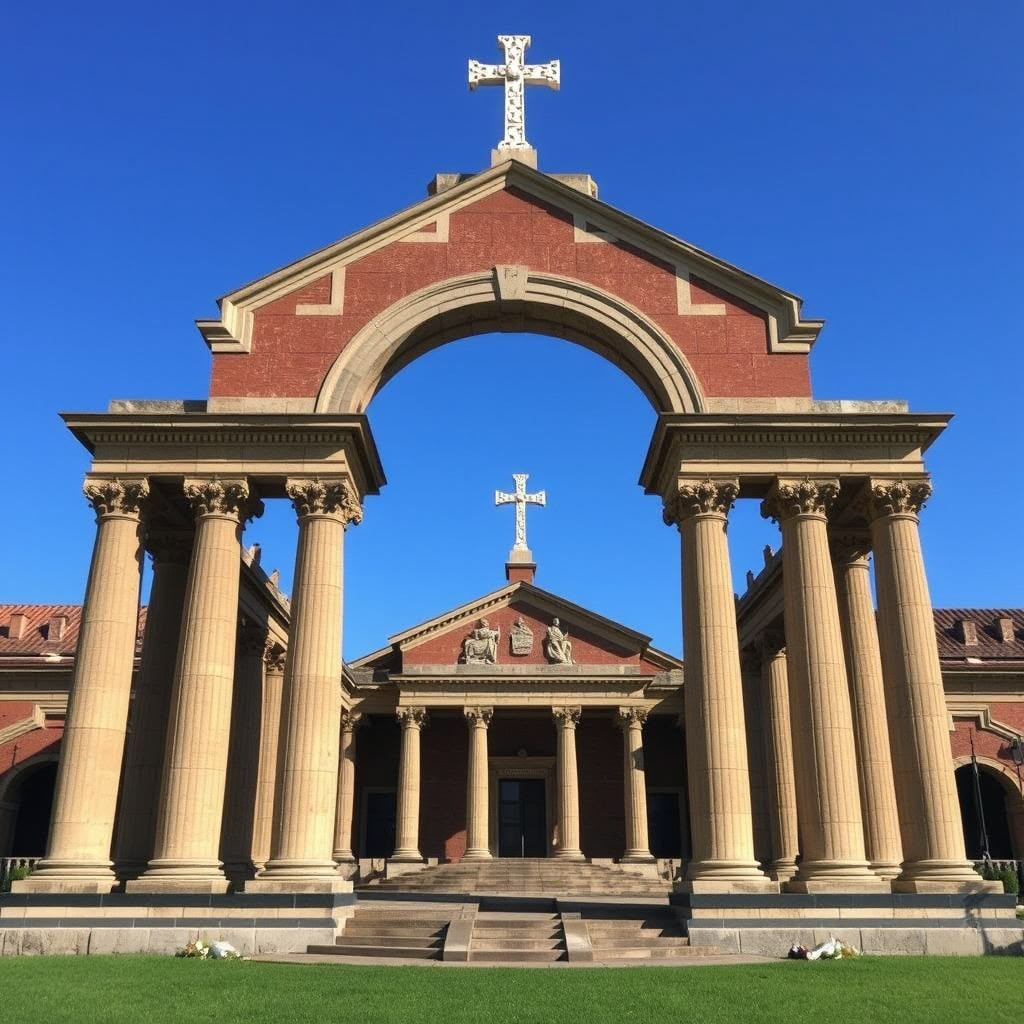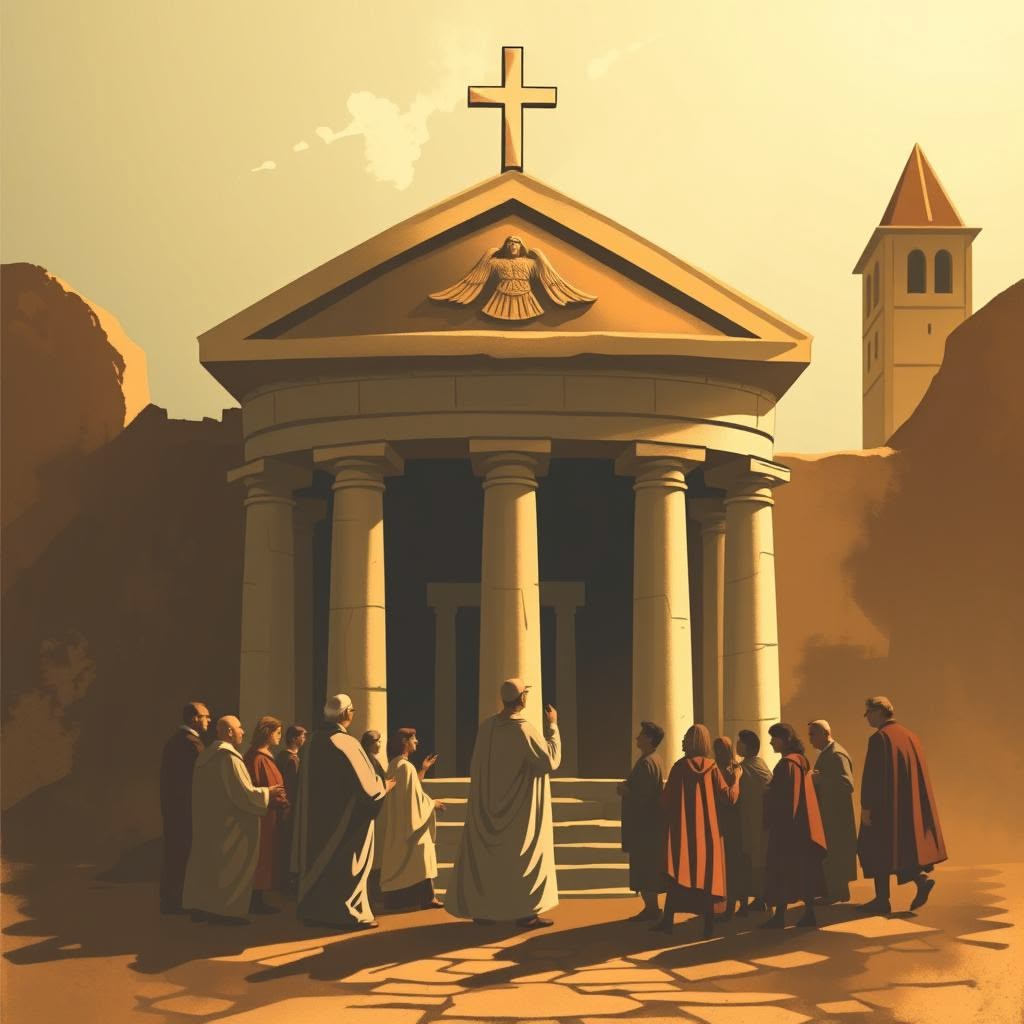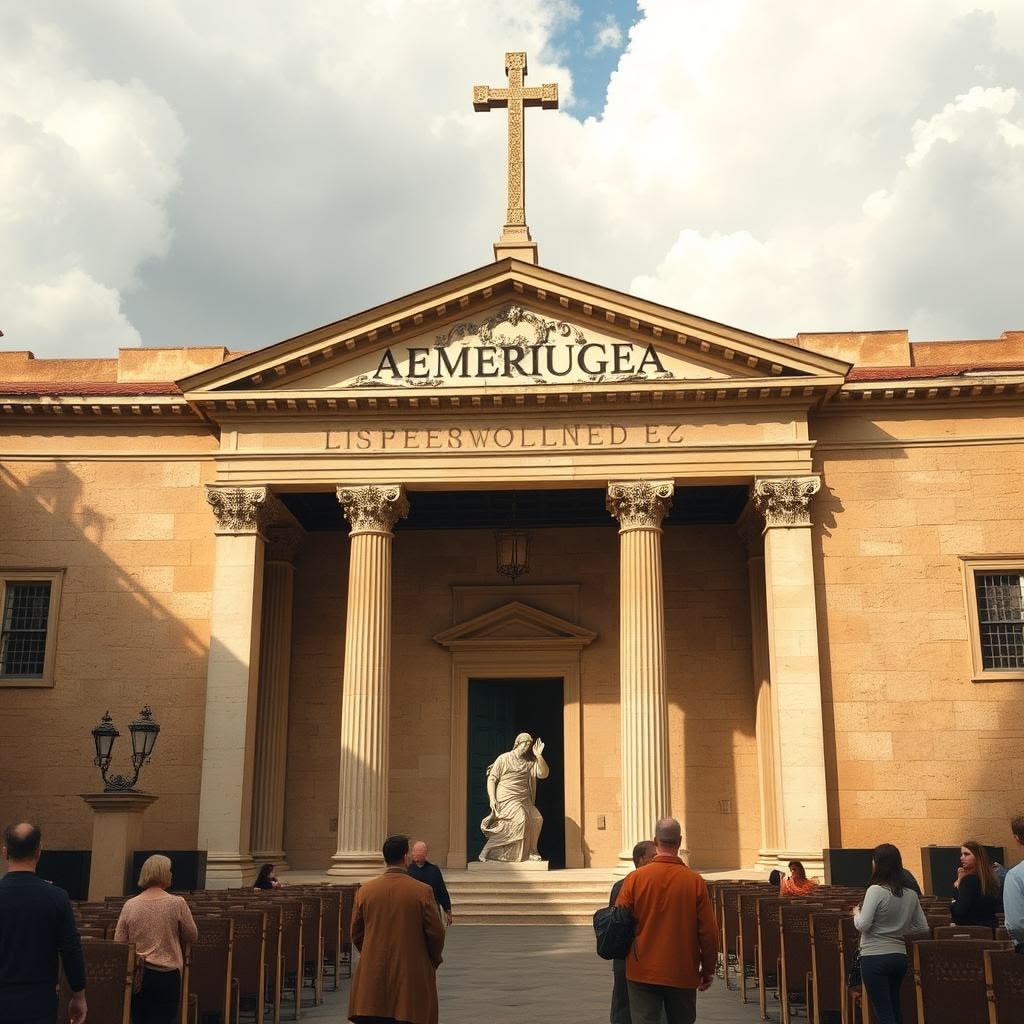The woman kneels before the altar, head bowed in prayer. Candles flicker around her, casting shadows on sacred images. She follows a ritual practiced for generations, confident in its authentic connection to her faith’s origins. Yet, unknown to her—and millions of other modern worshippers—many of these cherished traditions trace back not to their religion’s founders but to the temples and forums of Ancient Rome.
This religious inheritance remains largely invisible to those who practice it. When Christians celebrate Christmas near the winter solstice, Jews light Hanukkah candles, or Muslims circle the Kaaba, few recognize the Roman architectural, calendrical, and ritual templates underlying these practices. The Roman Empire’s genius wasn’t just in conquering territories but in creating religious frameworks so adaptable they’ve outlasted the civilization that created them by nearly two millennia.
Historians have long recognized Rome’s political and architectural legacy, but its religious influence remains surprisingly underexplored in popular understanding. “Most worshippers would be astonished to learn how many of their cherished traditions were shaped by Roman precedents rather than by their faith’s founders,” explains Dr. Katherine Harper, religious historian at Columbia University. “Rome didn’t just conquer physically—it conquered culturally, creating religious templates so effective they’re still in use today.”
The Roman fingerprints on modern faith aren’t evidence of inauthenticity but rather testament to how deeply interconnected human spiritual expression remains across time. Understanding these connections doesn’t diminish religious practice—it enriches it, revealing how our most sacred traditions exist within a continuous human conversation about the divine that spans millennia.
The Roman Calendar: Why You Worship When You Do
Open your calendar app. Scan through the months. January, February, March… each name a direct inheritance from Rome. But Rome’s influence extends far beyond month names. The entire structure of religious time—how faiths organize their worship year—follows templates established during the Roman Republic and Empire.
Consider Christmas. For centuries, Christians have celebrated Jesus’s birth on December 25th. Yet historians widely agree Jesus was likely born in spring or summer. The December date corresponds precisely with the Roman festival of Sol Invictus—the Unconquered Sun—established by Emperor Aurelian in 274 CE. As Christianity gained dominance, it didn’t eliminate this popular celebration but rather absorbed and reinterpreted it.
“Early Christian leaders were pragmatic,” explains Professor Marcus Jennings, author of Sacred Time: The Roman Origins of Religious Calendars. “Rather than eliminate beloved Roman festivals, they transformed them. December’s celebration of light conquering darkness worked perfectly as a metaphor for Christ’s birth. The existing festival infrastructure—already-established holidays when people expected to celebrate—provided a ready-made template.”
This pattern repeats across faiths. The Jewish calendar, while lunar-based and much older than Rome, underwent significant codification during the Roman period. The fixed calendar Jews use today was established in the 4th century CE, during late Roman rule. Even Islamic practices, though developing largely outside direct Roman control, incorporated aspects of timekeeping and seasonal observances that had been standardized throughout the Mediterranean world by centuries of Roman influence.
Easter provides perhaps the most fascinating example of Rome’s calendrical influence. Its date—the first Sunday after the first full moon following the spring equinox—relies on a complex calculation that combines solar and lunar elements. This system emerged from debates during the Council of Nicaea in 325 CE, convened by the Roman Emperor Constantine. The solution adopted was one that aligned with Roman administrative needs for predictability while accommodating Christian theological requirements.
Even the seven-day week, now standard worldwide, gained its definitive form under Roman influence. While the concept existed in various cultures, Rome’s adoption and standardization of the seven-day planetary week in the late Republic established the template we still follow. The days themselves—Sunday (Sun’s day), Monday (Moon’s day), etc.—remain named after Roman planetary deities in many languages.

Sacred Architecture: The Roman Template for Divine Space
Walk into most traditional churches, synagogues, or mosques, and you’re entering spaces whose basic architectural grammar was established by Roman builders. The rectangular hall, the central focus point, the processional approach—these fundamental elements of sacred architecture derive directly from Roman templates.
The Roman basilica—originally a secular building for business and government—provided the blueprint for Christian church architecture. When Emperor Constantine legalized Christianity in 313 CE, he donated imperial basilicas to the new faith. The basic floor plan—a rectangular building with a central nave flanked by aisles, culminating in an apse where important figures sat—transformed seamlessly into the Christian church layout. The magistrate’s chair in the apse became the bishop’s throne; the administrative functions replaced by liturgical ones.
Dr. Eliana Vasquez, architectural historian at Princeton University, notes: “Most churchgoers assume their church’s layout derives directly from early Christian practice, but it’s actually based on Roman administrative buildings. Early Christians simply repurposed existing architectural forms, and we’ve been using that template ever since.”
This Roman influence extends beyond Christianity. While synagogues predate Roman architecture, their standardized form—particularly the Torah ark’s placement and orientation toward Jerusalem—solidified during the Roman period. Archaeological excavations of ancient synagogues throughout the Roman Empire reveal increasing adherence to standardized architectural patterns that still influence synagogue design today.
Even mosque architecture, developing later and outside direct Roman control, shows influences from Byzantine architecture—itself a continuation of Roman building traditions. The courtyard (sahn), the prayer hall (musalla), and even the minaret have precedents in Roman and Byzantine structures. The Great Mosque of Damascus, one of Islam’s earliest and most important buildings, was constructed on the site of a Roman temple, incorporating existing Roman walls and spatial concepts.
Beyond basic layout, Roman decorative elements persist in religious buildings across faiths. Columns, domes, arches, and vaults—all Roman engineering innovations—remain standard features in houses of worship. The Pantheon’s revolutionary concrete dome in Rome has inspired religious domes worldwide, from St. Peter’s Basilica to Istanbul’s Blue Mosque.
This architectural inheritance isn’t merely aesthetic—it shapes how worshippers experience sacred space. The processional approach along a central axis, the hierarchy of spaces from public to sacred, the manipulation of light to create transcendent experiences—these Roman techniques for creating awe continue to influence religious experience regardless of faith tradition.

Ritual Forms: The Unseen Roman Structure of Worship
The woman dips her fingers in holy water, making the sign of the cross before entering the church. Across town, a man washes his hands and feet before entering a mosque for prayer. In a synagogue, congregants stand as the Torah scrolls process through the sanctuary. These diverse ritual actions share a common ancestor: Roman purification and processional practices.
Roman public religion was highly ritualized, with precise actions performed in specific sequences. This emphasis on correct ritual procedure—what scholars call orthopraxy (right practice) as opposed to orthodoxy (right belief)—has shaped how subsequent faiths approach worship. The Roman concern with ritual purity, proper preparation of sacred space, and correctly performed actions lives on in religious practices worldwide.
“Religious rituals don’t emerge from nowhere,” explains Dr. Jonathan Meyers, comparative religion professor at Yale University. “They build on existing cultural templates for proper interaction with the divine. Rome provided an exceptionally powerful template that subsequent faiths adapted rather than rejected.”
Consider the basic structure of many religious services: a gathering of the community, a processional entry of sacred objects or religious leaders, readings from sacred texts, communal responses, offerings, a central ritual action, and a formal dismissal. This pattern closely follows the structure of Roman public ceremonies, from religious festivals to governmental proceedings.
Even specific ritual elements show Roman origins. The use of incense in Catholic, Orthodox, and some Protestant services derives from Roman practices of fumigation and purification. Ritual hand washing before worship appears in Roman temples before being incorporated into Jewish, Christian, and later Islamic practice. The concept of a sacred meal sharing food that has been blessed or consecrated has roots in Roman sacrificial feasts.
Perhaps most striking is how Roman administrative vocabulary became religious terminology. Words like “diocese” (from Roman administrative districts), “pontiff” (from pontifex, a Roman priest), and “liturgy” (from Greek via Roman public service) reveal how thoroughly Roman organizational concepts shaped religious institutions.
The very concept of a professional priesthood with specialized garments, dedicated solely to religious functions and organized in hierarchical ranks, while existing in some form in earlier cultures, was standardized and institutionalized under Roman influence. The elaborate vestments of many religious leaders—special robes, headgear, and insignia—have precedents in Roman religious and civic dress.
Even religious music shows Roman influence. The development of Christian chant, particularly Gregorian tradition, builds on Roman melodic patterns and textual settings. The antiphonal singing (alternating groups) common in many religious traditions derives from Roman practice, as does the concept of a trained choir separate from the general congregation.

Venerating the Sacred: Images, Saints, and Mediating Figures
Enter virtually any Catholic or Orthodox church and you’ll find saints’ images adorning the walls. Visit certain Hindu or Buddhist temples, and deity statues fill sacred niches. Even in mosques, where figurative imagery is avoided, calligraphic representations of holy names serve similar functions. The practice of creating physical representations of sacred figures or concepts has deep roots in Roman religious practice.
Rome’s approach to the divine was distinctly practical. Gods were specialized, with different deities handling different domains of life. This specialization created a need for multiple divine representations and an understanding that approaching specific deities for specific needs was more effective than general prayers. This template—approaching specialized sacred intermediaries rather than always addressing the highest divine power directly—has profoundly shaped subsequent religious practice.
“The Roman concept of patron deities with specific domains created a template later filled by saints in Christianity, tzadikim in Judaism, walis in Islam, and bodhisattvas in Mahayana Buddhism,” explains Dr. Sarah Wintermuth, comparative religion scholar at the University of Chicago. “The notion that ordinary people might benefit from specialized divine intermediaries who could advocate on their behalf survived Rome’s fall and transcended religious boundaries.”
The physicality of Roman worship—the emphasis on images, statues, and visual representations of the divine—directly influenced how later faiths approached sacred representation. While some traditions, particularly Islam and certain Protestant denominations, rejected this visual emphasis, many others adopted and adapted it. Christian iconography, Hindu murti traditions, and Buddhist statue veneration all show patterns similar to Roman approaches to divine imagery.
Even religions that avoid human representation often maintain the Roman emphasis on sacred objects. The Torah scroll in Judaism, relics in Buddhism, and the Black Stone of the Kaaba in Islam fulfill similar functions to Roman sacred objects—physical items that connect worshippers to the divine through tangible presence.
The practice of pilgrimage to sacred sites, while predating Rome, was systematized under Roman influence. The Empire’s extensive road network and administrative standardization made regular, organized pilgrimages possible on an unprecedented scale. This infrastructure established patterns of sacred travel that continue today in traditions as diverse as the Catholic Santiago de Compostela pilgrimage, the Muslim Hajj, and Hindu visits to river confluences.
Beyond Appropriation: Understanding Religious Evolution
Recognizing Rome’s influence on modern religious practice raises important questions about cultural borrowing, appropriation, and authenticity. If so many aspects of modern faith follow Roman templates, are these practices somehow less authentic? The answer requires nuanced understanding of how religions naturally evolve.
“Religious traditions have always been in dialogue with their cultural surroundings,” notes Dr. Amir Hussain, professor of theological studies at Loyola Marymount University. “Rather than seeing Roman influence as ‘contamination’ of pure faith, we should understand it as part of the natural process through which religions adapt to and transform the cultures they encounter.”
This perspective challenges both religious fundamentalists who claim unchanged practices since their faith’s founding and secular critics who view religious borrowing as evidence of inauthenticity. The reality is more complex and more interesting: religions have always been dynamic, adaptive systems that incorporate elements from their surroundings while maintaining core principles.
Rome’s religious genius lay in creating templates flexible enough to accommodate diverse theological content. The basic structures—sacred spaces, ritual forms, calendrical systems, devotional practices—proved so effective at facilitating meaningful spiritual experience that they survived Rome’s political collapse and religious transformation.
Understanding this continuity enriches rather than diminishes religious practice. Recognizing that when you enter a cathedral, you’re experiencing spatial concepts refined in Roman basilicas connects you to thousands of years of human spiritual seeking. Knowing that ritual hand washing before prayer links Jewish, Christian, Muslim, and Hindu practitioners to common ancestral practices reveals the shared human impulse toward purification before encountering the sacred.
For historians and religious scholars, these connections provide invaluable insights into cultural transmission and religious development. “Tracing how Roman templates have been preserved, modified, rejected, and reinterpreted across different faith traditions reveals fundamental patterns in how humans conceptualize and approach the divine,” explains Dr. Victor Martinez, religious anthropologist at the University of California, Berkeley.
Living Legacy: Why Roman Templates Endure
The persistence of Roman religious templates across time, geography, and diverse theological systems raises a fundamental question: Why have these particular forms proved so enduring? The answer lies partly in Rome’s unparalleled opportunity to synthesize religious practices from across the ancient world.
As Rome conquered the Mediterranean, it encountered and incorporated elements from Greek, Egyptian, Persian, Celtic, and numerous other religious traditions. This position at the crossroads of ancient faiths allowed Rome to identify and refine the most effective practices from each tradition. What emerged wasn’t merely Roman but a sophisticated synthesis of diverse approaches to the sacred.
“Rome functioned as a religious laboratory,” explains Dr. Elizabeth Chen, ancient historian at Oxford University. “Its political dominance created space for unprecedented religious exchange, allowing effective practices to be identified, refined, and standardized across a vast territory. What we call ‘Roman’ religious forms often represent the distilled wisdom of dozens of earlier traditions.”
This synthesis was further strengthened by Rome’s pragmatic approach to religion. Unlike some traditions that emphasized correct belief, Rome focused on correct practice and measurable results. Rituals that produced desired outcomes—social cohesion, psychological comfort, sensory impact—were preserved regardless of their theological underpinnings.
The empire’s extensive infrastructure also played a crucial role in standardizing these practices. Roman roads, administrative systems, and later the institutional Church created unprecedented networks for transmitting standardized religious forms across vast distances. Local variations continued, but within recognizable templates that facilitated communication and mobility throughout the post-Roman world.
Perhaps most importantly, these Roman-synthesized forms proved exceptionally effective at addressing fundamental human needs for structure, meaning, and transcendence. The Roman genius lay not in creating entirely new religious concepts but in identifying which existing forms most powerfully facilitated authentic spiritual experience.
Reconsidering Your Religious Inheritance
Before encountering this information, you likely viewed your religious practices as direct inheritances from your faith’s founders—Jesus, Muhammad, Moses, or others. You may have assumed the structure of your worship, the timing of your holy days, and the form of your sacred spaces derived directly from original teachings or divine revelation.
Now, a more complex picture emerges. The founders and sacred texts of major faiths certainly provided core theological content and ethical teachings. But the forms through which these teachings are expressed—the when, where, and how of worship—often follow templates established during Rome’s cultural dominance.
This understanding doesn’t diminish authentic faith. Rather, it places your spiritual practice within a grand human conversation about the sacred that spans millennia and crosses cultural boundaries. When you celebrate a holy day, enter a sacred building, or perform a ritual, you’re not only connecting to your specific faith tradition but also to thousands of years of human spiritual seeking.
The next time you enter your place of worship, notice its spatial organization. Observe how architectural elements guide your attention and movement. Consider how the structure of the service—its progression, its ceremonial elements—might reflect Roman precedents. Recognize how the calendar of observances balances solar and lunar elements in ways that would be familiar to ancient Romans.
This awareness transforms religious practice from a static inheritance into a dynamic participation in ongoing human engagement with the divine. It reveals connections between faiths often perceived as entirely separate. It helps explain why certain religious forms feel intuitively right across cultural boundaries—they’ve been refined over millennia to resonate with fundamental human spiritual needs.
As Dr. Katherine Harper concludes: “Understanding the Roman templates underlying modern religious practice doesn’t make that practice less authentic—it makes it more profound. It connects us to countless generations who found meaning through similar forms, reminding us that while theological beliefs may divide, the human impulse toward sacred connection unites us across time and tradition.”
The woman kneeling in prayer, the man washing before worship, the community gathered around sacred texts—all participate in patterns established long before their specific faiths emerged. In their practices, Ancient Rome lives on, its genius for creating effective sacred forms continuing to shape how humanity reaches for the divine in the twenty-first century and beyond.

